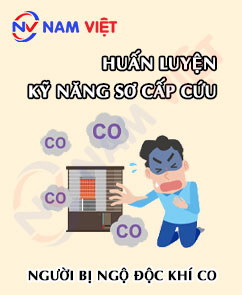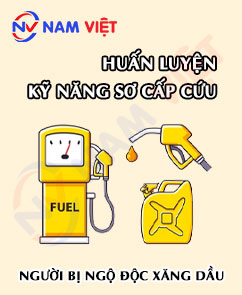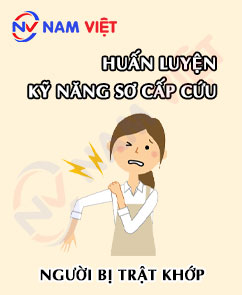First aid training for individuals poisoned by carbon monoxide (CO)
500,000 ₫
Note: The above price is calculated per person. Prices may vary depending on the number of participants in the course and market fluctuations. For more accurate pricing, please refer to the price list or contact our consulting staff directly.
Table of Contents
Toggle1. Identifying Carbon Monoxide (CO) Poisoning Victims
a. Cases of CO poisoning
Carbon monoxide (CO) poisoning occurs when a person inhales CO, a colorless, odorless, and highly toxic gas. CO is produced during the combustion of fuels such as coal, oil, and gas. Cases of CO poisoning may include:
- CO poisoning at home: Causes may include using water heaters, gas stoves, or heaters without proper ventilation, burning coal or wood indoors, or running vehicles in enclosed garages.
- CO poisoning in vehicles: Often caused by exhaust gases not being properly vented outside.
- CO poisoning in public areas: Places like power plants, chemical factories, industrial zones, apartment buildings, or hotels may pose a risk if ventilation systems or exhaust fans are not functioning properly.
CO poisoning cases can present different symptoms depending on the amount of CO inhaled and the duration of exposure.

b. Signs someone may be suffering from CO poisoning
Some signs of CO poisoning may include:
- Headache and dizziness
- Nausea and difficulty breathing
- Fatigue and weakness
- Symptoms resembling pneumonia or cold
- Red or deep red skin color
- Palpitations and anxiety
- Unconsciousness or alertness, but possible memory loss or difficulty thinking or moving
If multiple people in the same environment exhibit similar symptoms, especially in an unventilated room, CO poisoning is likely.

c. Assessing the condition of a CO poisoning victim
CO poisoning is dangerous and requires prompt treatment. Possible conditions in CO poisoning victims include:
- Difficulty breathing: CO binds to hemoglobin, forming carboxyhemoglobin, reducing oxygen delivery to body cells.
- Headache: The most common symptom due to CO reducing oxygen supply to the brain.
- Nausea and vomiting: CO irritates the stomach and increases intestinal activity.
- Fatigue and dizziness: Reduced oxygen supply causes tiredness and lightheadedness.
- Reduced vision and hearing: CO affects blood flow to the retina and auditory system.
- Alcohol-like behavior: Victims may slur speech or act abnormally, similar to being intoxicated.
If these symptoms are observed or CO poisoning is suspected, immediately remove the victim from the CO-exposed area and perform first aid.

d. Golden time for CO poisoning cases
The golden time for CO poisoning is critical and requires immediate action. CO binds to hemoglobin, preventing oxygen exchange in the blood, leading to hypoxia and respiratory or blood pressure complications. Untreated, CO poisoning can cause brain damage and even death.
The golden time for CO poisoning is within 1-2 hours after exposure. During this period, oxygen therapy and prompt transfer to a hospital are essential.
Victims should be moved to a safe area with clean air and assisted with oxygen inhalation if available. Call emergency services to report the condition. While waiting for help, ensure the victim breathes clean air and provide support until professional medical help arrives.
2. Overview of First Aid Training for Carbon Monoxide (CO) Poisoning Victims
a. What is a first aid training course?
A first aid training course teaches both basic and advanced first aid skills. It includes lessons and practical exercises on handling emergencies such as cardiac arrest, respiratory failure, poisoning, injuries, and other urgent situations.
The course equips learners with skills to respond effectively to emergencies, minimize harm to themselves and others, increase survival chances, and ensure timely medical care.
REGISTER FOR BASIC FIRST AID TRAINING
b. Training duration
Initial first aid training:
- For employees: 4 hours.
- For first aid and emergency responders: 16 hours (2 days).
Periodic first aid training:
- For employees: 2 hours.
- For first aid and emergency responders: 8 hours (1 day).
c. Course content
- Basic principles of first aid and on-site emergency care
- Wound bandaging (principles, tools, techniques)
- Temporary bleeding control techniques (principles and methods)
- Temporary fracture stabilization techniques (principles and tools)
- Cardiopulmonary resuscitation (recognizing cardiac arrest, airway clearance, breathing support, CPR guidance)
- Burn management (assessing cause and severity, on-site first aid)
- Safe victim transportation with and without stretchers for initial care
- Specific emergency care scenarios:
- Electric shock
- Drowning
- Chemical accidents
- General guidance on first aid kit use
- Practical exercises for all content areas
d. First aid training certificate
Upon completing the course, learners receive a certificate confirming completion of the first aid training program under the Group 2 training framework as specified in Appendix IV, Decree 44/2016/ND-CP. The certificate is valid for 1 year.


3. Essential Tools for a First Aid Kit in Case of Carbon Monoxide (CO) Poisoning
The essential tools for a first aid kit in cases of CO poisoning include:
- Gas mask: Used to protect the rescuer’s respiratory system from exposure to CO gas.
- Oxygen tank: Used to supply oxygen to the victim if necessary.
- Adhesive tape and cotton: Used to dress the victim’s wounds.
- Nose clips and airway tubes: Used to ensure the victim’s airway is not blocked.
- Salt water bottle: Used to rinse eyes or cool skin exposed to toxic gas.
- Flashlight: Used to provide light when needed.
- Gloves: Used to protect the rescuer’s hands from contact with toxic substances.
- Adhesive bandages: Used to dress wounds.
- Fabric scissors: Used to cut the victim’s clothing if necessary.
- Oxygen supply bottle: Used to administer oxygen to the victim if needed.
- Blood pressure monitor: Used to check the victim’s blood pressure.
- Thermometer: Used to measure the victim’s temperature.
- Painkillers: Used to relieve pain for the victim if necessary.
- Ice pack: Used to cool burned or swollen areas of the skin.
Note: In addition to these tools, other equipment may be required depending on the specific situation.
REGISTER FOR BASIC FIRST AID TRAINING
4. First Aid Procedure for Carbon Monoxide (CO) Poisoning Victims
The first aid procedure for CO poisoning victims includes:
- Move the victim out of the CO area: First, bring the victim to a safe, well-ventilated area with fresh air.
- Call emergency services: Immediately after moving the victim, call emergency services for guidance on first aid and transport to a hospital.
- Perform first aid: While waiting for the rescue team, take the following steps:
- Check the victim’s breathing: Determine if the victim is breathing and note the breathing rate. If the victim stops breathing, perform CPR immediately.
- Check the heartbeat: Check the victim’s pulse. If irregular or absent, start CPR immediately.
- Support breathing: If the victim is still breathing, place them in a semi-upright side position and ensure the airway remains clear.
- Keep the body warm: CO poisoning can reduce body function, so cover the victim with a blanket or jacket to maintain warmth.
- Transport to hospital: Once the rescue team arrives, ensure the victim is taken to a hospital for further treatment. Delayed hospital care can be life-threatening.
5. Benefits of First Aid Training
First aid training provides many important benefits for individuals and the community:
- Saving lives in dangerous situations: First aid skills enable trainees to save people whose lives are at risk, such as cardiac arrest, respiratory arrest, poisoning, injuries, and other emergencies.
- Helping others learn first aid: Trained individuals can share their knowledge and experience with others, helping the community protect itself and reduce fatalities in emergency situations.
- Reducing waiting time for rescue: When trained first aiders handle emergencies on-site, waiting time for rescue teams is minimized.
- Enhancing response and reducing stress in emergencies: First aid training equips learners to respond accurately and quickly, lowering stress and anxiety while awaiting help.
- Increasing survival rates and reducing fatalities: Timely and proper first aid improves survival chances and reduces complications or deaths in emergencies.

6. First Aid Training Capacity of An Toan Nam Viet
An Toan Nam Viet is a reputable and high-quality first aid training center in Vietnam. Training sessions are conducted continuously at workshops, factories, and construction sites nationwide (all 63 provinces of Vietnam).
REGISTER FOR BASIC FIRST AID TRAINING
Training Certification
- An Toan Nam Viet has been inspected and certified by the Department of Safety under the Ministry of Labor – Invalids and Social Affairs for occupational safety and hygiene training. Within the Group 2 training program, the first aid skills module is included, further strengthening our capacity in first aid training.

Training Materials and Lectures
- Before being used in first aid courses, training materials are reviewed to ensure accuracy and practical effectiveness.
- Instructor methods are standardized according to An Toan Nam Viet standards, developed by experts in first aid training to maximize knowledge retention for learners.
Facilities
- Controlling factors in the training room enhances teaching efficiency and knowledge absorption.
- Our training facilities provide spacious classrooms meeting standards for space, lighting, and training equipment.
7. Nationwide First Aid Training Centers
An Toan Nam Viet is one of the most reputable and professional organizations for first aid training in Vietnam. With experienced instructors, modern equipment, and high-quality programs, the center has become an ideal destination for those interested in protecting lives and health.
By attending courses at An Toan Nam Viet, you will learn basic and advanced first aid skills, from CPR for cardiac arrest, respiratory arrest, poisoning, injuries, to handling other emergency situations. The program is flexible and suitable for all learners, including adults, children, medical staff, rescue personnel, and the general public.
An Toan Nam Viet’s first aid training not only teaches essential life-saving skills but also fosters awareness to protect your own life and health as well as those around you. Training by experienced and highly qualified instructors ensures confidence and readiness for any emergency situation.
Register for first aid courses at An Toan Nam Viet to protect your life, health, and the community.
1 review for First aid training for individuals poisoned by carbon monoxide (CO)
No comments yet












phanminhhang341
Very good and professional first aid training unit